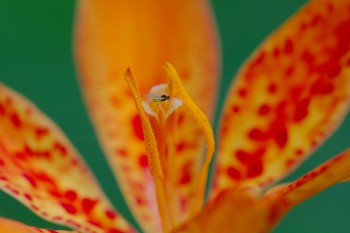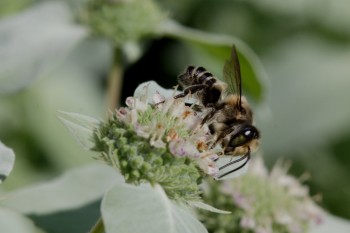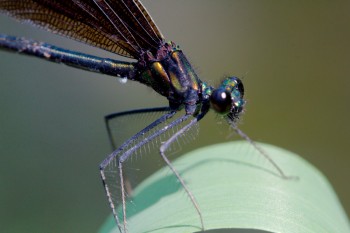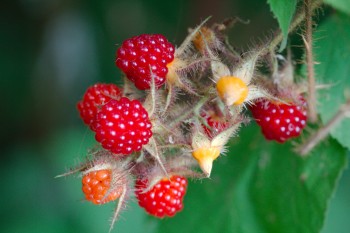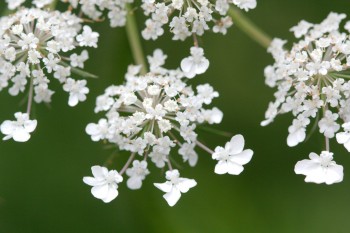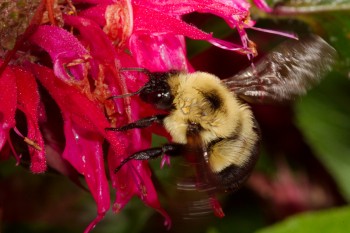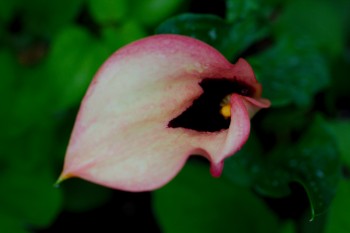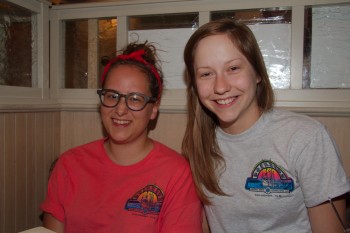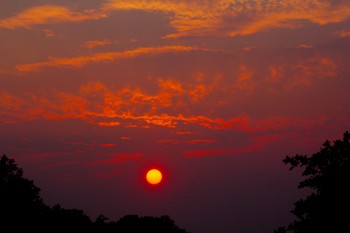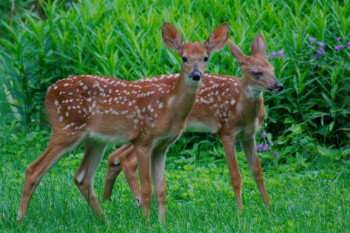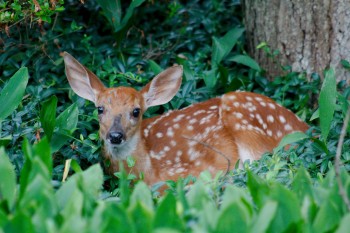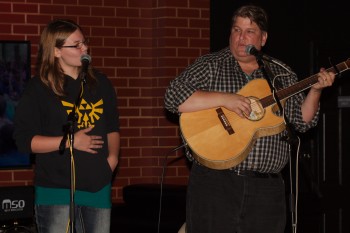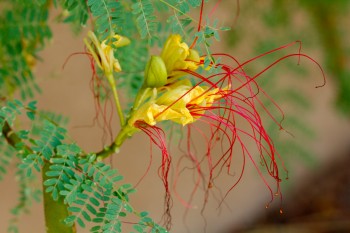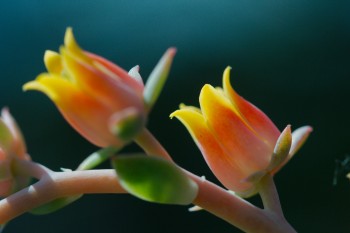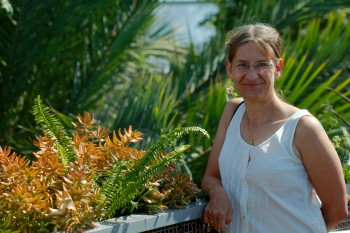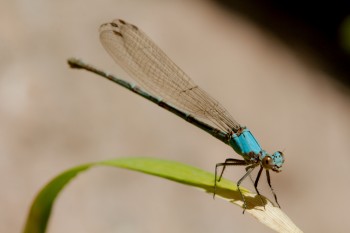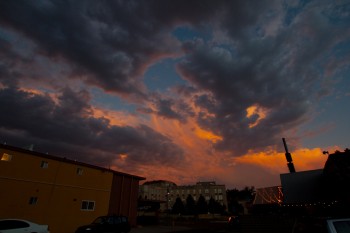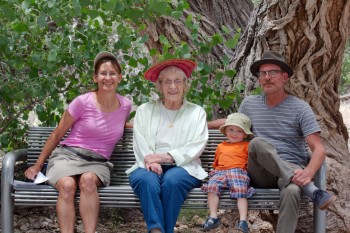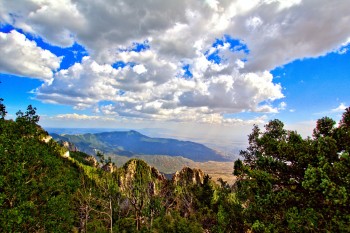The blackberry lily, formerly Belamcanda chinensis, but now Iris domestica, has started to bloom. I collected seeds for this many years ago and I’ve had it growing around the yard ever since (and our previous yard before that). I gather the seeds each fall and spread them liberally and I’m pretty much happy to have them come up wherever they can. This one has a very tiny aphid on the stigma.
Iris domestica (Blackberry Lily) with Aphid
Megachile (Leaf-cutter Bee)
I haven’t taken the time to get a firm identification on this little bee, and the picture isn’t really good enough for a definitive ID in any case. I’m pretty sure, off the top of my head, that it is a leaf-cutter bee in the genus Megachile. The mountain mint (Pycnanthemum muticum) is at its peak (which lasts for a good long while, actually) and the bees are all over it, particularly when the sun is shining on it. That’s good for photographing them, of course, as the more light the easier it becomes, but it does mean I’m working in the bright, afternoon sun. Still, it’s one of my favorite things to do on a Saturday.
Calopteryx maculata (Ebony Jewelwing)
It’s high season for dragonflies and the pond next to my building is a good spot for finding them. Of course, taking pictures of them takes a little more than a camera and a good location. You also need a fair amount of patience. They tend to be shy and fly away when you get too close. Getting close is fairly important, though. I found a good spot, got reasonably comfortable, and waited. This female ebony jewelwing (Calopteryx maculata) landed nearby and then moved even closer. Close enough for a pretty near view.
Raspberries
I had a meeting over in the next building early this afternoon so I brought my camera and took a few pictures as I walked by the woods between buildings. There are raspberries ripe and starting to look quite good. I didn’t have time to pick many, but I took a picture of a few before pulling them off and munching on them as I finished my walk. Wild raspberries are one of the best things about the woods around here. Delicious.
Queen Anne’s Lace (Daucus carota)
We have a Queen Anne’s Lace (Daucus carota), otherwise known as wild carrot, growing at the corner of the garage. It isn’t doing any harm in terms of overrunning our garden, at least not so far, and we decided to let it stay at least as long as it’s in bloom. This is close-up of one small cluster of flowers in one of the large clusters that make up the flowering head of the plant.
The family to which Queen Anne’s Lace belongs (Apiaceae, the celery, carrot or parsley family) contains quite a few plants familiar to cooks for root vegetables (carrot, parsnip), stems and leaves (celery, parsley, coriander/cilantro) or seeds (anise, caraway, coriander, cumin, dill, fennel, etc.). The family also contains some dangerous plants, like the giant hogweed, the sap from which can cause severe burns through phytophotodermatitis, and hemlock, with its cocktail of poisonous alkaloids and of Socrates-killing fame.
Eastern Cottontail (Sylvilagus floridanus)
We have a huge number of rabbits in our neighborhood. I don’t think a day goes by that I don’t see at least one in our yard. There’s a very small one that we see in the back yard. When I pulled into the driveway this evening, fortunately with the windows open in my car, this little fellow (or filly) was munching on grass fairly close to the driveway. I was able to pull out the camera and get a few pictures before he got spooked and ran off.
Bumble Bee on Monarda
The bees are starting to get quite active now. They start when things start blooming, of course, and are never really far. But in the heat of July, when the flowers of summer are at their densest, they are easiest to find. The monarda (the aptly named bee balm) seems particularly attractive to bumble bees. The flowers are a bit past in terms of their looking all pretty for photography but the bees don’t seem to mind. I went out this evening and spent a while chasing bumble bees (Bombus impatiens) from flower to flower. This shot turned out reasonably well—the body if fairly sharp while the wings are blurred with motion.
Hope and Grace2
Our church has a longstanding tradition, going back at least a month, that on the first Sunday of each month we have a lunch together before our service, which is at 2:30 in the afternoon. It was such a beautiful day today and being the Fourth of July weekend, we thought a picnic would be appropriate. I took a few pictures and it wasn’t hard to pick this one as my favorite. The girls are Hope, Grace, and Charis (from the Greek χάρις, meaning grace). So, Hope, Grace, and Grace (or Grace2).
Calla Lily
Sometimes our days don’t go according to plan. Sometimes I think we should be more surprised when they do go according to plan. We expected to go to watch fireworks this evening. It’s a pretty simple plan and fairly common for July 4 in the good, old U.S. of A. Didn’t happen.
Without giving too much personal information (because anyone who needs to know the details already knows them), we spent the afternoon and evening in the ICU in Bethesda. Also, although we did not get word until tomorrow (in our time zone), so it wouldn’t have kept us home anyway, Cathy’s sister passed away late today. This calla lily is in honor and memory of her.
Dorothy and Karlee
I enjoyed photographing a wedding today so I actually have quite a few photographs that I could post. But I don’t really know the bride and groom, just the groom’s parents, so I decided I would pass on that and post this picture, taken later in the evening. Dorothy and Karlee went up to Frederick for the day today and then when I got home, we went out to IHOP for a late dinner. That’s where this picture was taken. So sad that we won’t have these two girls at the beach with us this year.
Sunset
An obvious difficulty when taking a photograph that includes the sun is that it’s fairly bright. I mean, that’s pretty obvious, I guess, but what do you do about it. It isn’t just bright, it is very, very bright. If you shorten the exposure so that the sun doesn’t overwhelm the photograph, then the rest of the sky becomes very dark.
One obvious thing to do is wait for a sunset when the sun is rendered darker due to atmospheric conditions. At times like that, the number of stops between the brightness of the sun and the sky is reduced to a more manageable amount. Even so, there is still a difference. I confess to cheating a little for this image. In the original the sun is nearly pure white, still having been overexposed a bit. But I took various exposures, including one that is three f/stops darker (1/3200 of a second instead of 1/400). The sun you see in this image came from the darker image, while the rest is from the lighter. It works, though, because that’s actually the way our eyes see the scene, having more dynamic range than camera sensors.
Two Fawns!
Generally I try not to post a picture of the same general subject two days in a row. If we’re travelling then I might, or if there is some multi-day event going on, but particularly in the when I’m just taking pictures in the back yard, I try not to. Well, for yesterday I posted a picture of a white-tail deer fawn. This evening there were two. How could I not go out and take pictures of them and post one of those? So, here are two white-tail deer fawns.
White-tail Deer Fawn
For the last few days we’ve had this white-tail deer fawn in our back yard. He seems to sleep in the center of the yard, under a tree in the middle of a bed of lesser periwinkle (Vinca minor) and lily-of-the-valley (Convallaria majalis) but if disturbed he will run behind the roses along the back fence. Like most fawns he is safest if predators don’t see him, so he remained alert but still as I approached this morning. When I got too close, of course, he had no choice but to get up and move. Not that I’m a predator, exactly, but he doesn’t know that.
Julia and Bob
After work today Cathy and I went to a benefit dinner for a non-profit run by some friends. We had a nice meal but more enjoyable still was the company. It’s good to connect with folks that we don’t see often enough and with our recent travel and how busy it’s been at work, it’s been worse than usual. We sat with Bob, Maureen, and Julia, among others, and especially enjoyed Bob and Julia singing for us. The acoustics were not fabulous and there was a bit of noise in the room (you can’t get people to stop talking at an event like this) but they did a great job. I think they are singing “Mrs. Robinson” by Simon & Garfunkel.
Rockville, Jupiter, and Venus
We had dinner with family this evening at a favorite Chinese restaurant and when we came out, the sky to the west was that wonderful, dark, almost-black, blue overhead fading to a paler blue towards the horizon. Jupiter and Venus were quite close together, seen here on the left a little above the center of the photo. In the other direction, the moon was quite beautiful and had Saturn visible right next to it.
Caesalpinia gilliesii (Yellow Bird of Paradise)
It was our last day in Albuquerque and we were sad to be leaving. I took a few pictures of Bert and Jane’s front yard while the others visited. Robert has done a nice job of xeriscaping the front yard and has three things that I photographed and identified. First, there are small, yellow chocolate flowers (Berlandiera lyrata), a member of the Compositae (or Asteraceae) family. There is also a red yucca, or more properly redflower false yucca (Hesperaloe parviflora, which is quite nice and actually seems to be quite hardy and might be worth finding for our yard, possibly in a container. Finally, there is the plant pictured here, the yellow bird of paradise (Caesalpinia gilliesii), which is a legume (family Fabaceae), not anything like the regular bird of paradise, which are in teh genus Strelitzia. It’s quite pretty, anyway.
Albuquerque Botanical Garden
David was going to pick up his and Cathy’s mom later this morning so Cathy and I had a little free time. We drove to the botanic garden, which is part, along with the zoo, aquarium, and Tingley Beach, of the Albuquerque Biopark. It is a relatively green and lush oasis in the high New Mexico desert, close to the Rio Grande and near the heart of the city. We enjoyed pretty much each of the various gardens and the two conservatories. One of the two conservatories is dedicated to Mediterranean plants and is very lush and wet. One thing they have a lot of there are sedums, of which Cathy is very fond. I particularly like them in bloom and this first photo is of a couple sedum flowers.
Cathy posed next to a large container of sedum and fern (the sedum is the brownish colored plant). We enjoyed the well established portion of the rose garden. There is a new section that looks like it was only completed this spring and the plants are still quite small but should be very nice in a year or two. The Japanese garden is lovely, although the local, southwest plants predominated, the feel was still appropriate for the name. Wood ducks and a black-crowned night heron were a nice addition.
We walked out to the farthest garden area of the park, past Heritage Farm to the Cottonwood Gallery. This is a more natural setting with all native and naturalized plants, predominated by the local cottonwood tree. They were shedding their seeds, which are attached to cottony hairs, giving the trees their common name, and covering the ground with a cottony fur. We saw a cottontail rabbit, as well, and lots of dragon- and damselflies, including this blue damselfly.
Sunset, Albuquerque, New Mexico
Pretty much everywhere has sunsets. Same sun, even. Some places the atmospheric conditions are generally more conducive to pretty sunsets than others, but they can be fine wherever you are, if you are fortunate. We had a lovely sunset after dinner this evening after a rainbow before dinner. This is looking southeast, actually, which generally isn’t the direction for the best sunset pictures, but when you are in a town or city, sometimes you don’t have an uninterrupted view to the west and you have to make do. This will do, I think.
Rio Grande Nature Center
David took us to the Rio Grande Nature Center this morning, less than ten minutes from where he lives. It was pretty hot out today so we spent a while in the building, enjoying the view out over the pond where there were ducks, turtles, a swan and quite a few smaller birds. Cathy and I walked across the Paseo Del Bosque Trail to the Rio Grande and back, seeing lots of dragonflies, a huge toad, and quite a few lizards. Before we left I took a few pictures of the rest of the group on a bench sitting in the shade of a good size cottonwood tree.
View From Sandia Crest
Cathy and I had some free time this afternoon, along with a rental car. It was quite warm in downtown Albuquerque so I thought a quick drive up to Sandia Peak would be nice. It was considerably cooler at 10,678 ft (3,255 m) but we sure felt the altitude. It was quite hazy, particularly to the west, looking out over the city, but to the south a little less so and I got this photograph, which I think is pretty nice. You can just see the edge of Albuquerque to the right of center. We also enjoyed the wildflowers on the mountain: Western Wallflower (Erysimum capitatum), Star Solomon Seal (Maianthemum stellatum), Scarlet Paintbrush (Castilleja miniata), Rocky Mountain iris (Iris missouriensis), and more. There was even a wild (or feral, perhaps) clematis.

